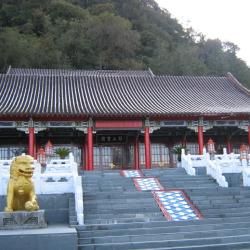Built in 1965, Lishan Hotel is located in the center of Lishan district. It was the earliest hotel built in the area, also one of the main hotels where President Chiang Kai-shek hosted foreign guests and stayed when he visited Taiwan. Designed by the same architect as Taipei Yuanshan and Kaohsiung Yuanshan, which are known as the three major palace hotels in Taiwan, the red exterior architectural features has become a landmark of Central Cross-island. The hotel began to operate in 1971 and was run by the National Military Retired Officers and Soldiers Guidance Committee of the Executive Yuan. It ceased operation after the 921 earthquake and Typhoon Minduli in 2000, and since it has not been maintained for more than a decade, it has lost its original glamour. In 2004, the hotel was taken over by the Shenshan National Scenic Management Offce, and was entrusted to be operated and managed by Lishan Hotel Co., Ltd. The hotel was rebuilt and reopened in December 2012.
Atayal
The Songmao Hamlet is located 3 kilometers to the northeast of Lishan, on section four of Zhongxing Road, Lishanli, Heping District, Taichung City to be exact. It is located on the shoulder-shaped flat edge between Dajia River and its tributary Hehuan River, with an altitude of about 2,300 meters. During the Japanese occupation period, there was a Taibajiu police post in the area, so it was named "Taibaojiu"; Taibaojiu was also spelled "タボク" (Taboku) in Japanese, so the residents often referred to the community as "Tabok". After the war, the residents moved to the current site on the side of the road. The origin of the name Songmao is unknown, but it may be related to the variety of Songmao pear.
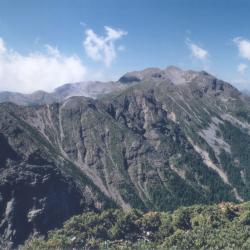
Xueshan is located at the junction of Heping District, Taichung City and Tai'an Township, Miaoli County. It is 3,886 meters above sea level and is the second highest peak in Taiwan. In July of the 4th year of Taisho (1915), Saitsu Kyuhei, the survey team of the Fan Affairs Bureau, and his party, crossed the southern saddle of Pyanan(now Siyuan Yakou) from the southern part of Beiyanshe (now Nanshan Village) to Zhijiayangshe (now Huanshan hamlet), followed by Zhijiayang Dashan ridgeline to complete the first ascent and measurement of the main peak of the snow-capped mountain. Since then, this route has become the most convenient way to climb the sub-alpine mountain (the name of Xueshan during the Japanese occupation). In the 4th year of the Showa era (1929), the governor of Taichung prefecture built the "Chigao Lodge" in the southeastern part of Xueshan, which was the only lodge in the area that accommodates hundred people. After the opening of the Xueshan Mountain Route in 1970, it replaced the Zhijiayang Line as the main route for climbing Xueshan because it was relatively gentle and easy to walk.
Inside the Siyuan Yakou pavilion, there is a "Central Cross-island Highway Yilan Branch Project Monument", which records the beginning and end of the road construction project. On the back of the stele, there are four words "Ying Shui Si Yuan" (meaning: drink water and remember the water source, be thankful) inscribed by General Zhou Zhirou, the then chairman of the Taiwan Provincial Government in August 1961. This is the origin of the place name "Siyuan Yakou". The Yilan branch line of Central Corss-island Highway began construction in January 1955 and completed in March 1959, with a total length of 111 kilometers. The predecessor of this road was the Pyanan Historic Trail during the Japanese rulw. In order to facilitate traffic and manage the indigines, the Japanese began to build the trail in the 7th year of Taisho (1918), which extended from today’s Leshui Village in Yilan County, passing through Mao'an, Siji, Nanshan, Siyuan Yakou in Taichung City, Huanshan, Lishan, Mailiguan in Nantou County, Marleba, Hongxiang, Ruiyan to Wushe, with a total length of about 120 kilometers. It was completed in the 10th year of Taisho (1921).
During the Japanese colonial period, in order to facilitate transportation and manage the indines, the Pyanan Historic Trail began to be built in March of the 7th year of Taisho (1918). The route goes through Huanshan, Lishan, Heping District, Taichung City, Cuiluan, Wangyang, Hongxiang, Ruiyan, and Wushe, Renai Township, Nantou County, with a total length of about 120 kilometers. It was completed in March 1921. This route was originally an aperture for the communication between the north and the south of the Atayal people. After excavation, it also became an important road for the "group migration" of the Atayal people. At present, this historic trail has been replaced by the Yilan branch line of the Central Cross-island Highway and the Lixing Industrial Road, leaving only two sections of the trail that do not overlap with the highway. One is the section from Yorkejiaoxi to Siyuan Yakou, and the other is from Lishan Anbu to Fushoushan farm.
Nanshan Elementary School is located in Nanshan village, at an altitude of almost 1,200 meters. It is an indigenous school with Atayal culture. The predecessor of Nanshan Elementary School was the "Pyanan Indigenous Children's Education Center" during the Japanese occupation period. It was established in May of the 9th year of the Taisho era (1920). In November of the same year it was open for school. In September of the 10th year of the Taisho era (1921), it was changed to "A-type Indigenous Children's Education Center", and the additional school building was completed in December of the same year. In May 1946, it was taken over by the National Government and changed to "Beinan Branch of Siji National School in Taiping Township, Taipei County". In August 1962, it became independent as "Nanshan National School in Datong Township, Yilan County". In August 1968, the nine-year national education was implemented, and the school was renamed "Nanshan National Elementary School". In 1991, the reconstruction of classrooms, dormitories and playgrounds was completed.
The Nanshan Tribe is located at 28K of the Taiwan Provincial Highway 7 of the Central Cross-island Highway Yilan Branch Line, at an altitude of 1,200 meters. It is a river terrace on the left bank of the upper reaches of the Lanyang River. It was originally called pyanan, meaning cooking, because in the past, the Atayal people often rest and cook here. In 1959, the Yilan branch of the Central Cross-island Highway was built. At that time, Premier Jiang Jingguo of Executive Yuan passed by here and felt that the name of Pyanan was indecent, so he took the word Nan and changed the name of the village to Nanshan Village. Nanshan Village is divided into upper and lower hamlets. Kanaban is the lower hamlet, and is located about 300 meters north of the Nanshan Police Station. It is the original location of Pyanan Hamlet and as it locates belo the terrace, it is called the lower hamlet. Koxao is the upper hamlet. In 1913, the Japanese forces penetrated into the Nanshan area and set up a station at the current site of the Nanshan police station. In order to disperse the power of the indigines, the leader Losin-nobo moved half of the community members to live near the station and called it Koxao because of its nose-like landform.
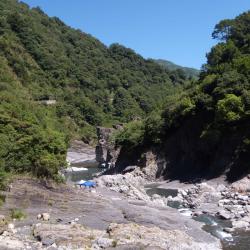
Where Taigang and Baishi River join is called Yufeng River. After crossing Xiuluan, you can see a huge rock on the other side of the river that looks like a sailing warship protruding from Yufeng River. During the Japanese rule, there was a suspension bridge that led to Zhishengmaotai Mountain on the opposite bank. The bridge was demolished in the 1970s because it was unsafe for crossing. In addition to the Xiuluan Hot Spring below the Xiuluan hamlet, you can also see bubbling river surface below the Junjianyan (Warship Rock), were hot spring gushes out from the rock crevices. It is the outcrop of Junjianyan Natural Hot Spring, a carbonated spring with a water temperature of about 50 degrees celcius. It is suitable for bathing when the temperature is adjusted through mixing stream water and hot springs. Tourists often camp near Warship Rock during holidays.
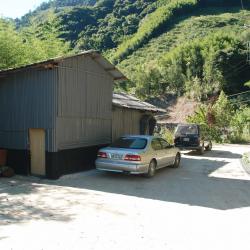
The location of the Yanglao Police Post from the Japanese rule has been converted into a working house today due to the widening of the road. Yanglao Hamlet belongs to Xiuluan Village, Jianshi Township, Hsinchu County. It is located on the left bank of Xiuluan River and the northern foot of Mount Sinaji, at an altitude of 900 to 1500 meters. The mountainside belongs to the Kinaji group of the Atayal ethnic group. Yanglao is a transliteration of Yuluw in the Atayal language, which refers to the rat board under the barn.
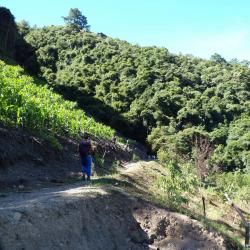
Departing from the entrance at the Yanglao end, heading towards the millet garden, you will see orchards on both sides of the road. The entrance at the Yanglao end is about 1250 meters. After passing the orchard, it is a gentle uphill slope. Since this is a middle altitude area, there are many different broad-leaved tree species, such as green maple, Taiwan alder, liquidambar, and some coniferous trees. The trail is about 3.5 kilometers and takes an hour. When entering the osmanthus bamboo forest, you will see a round charcoal kiln by the trail.
